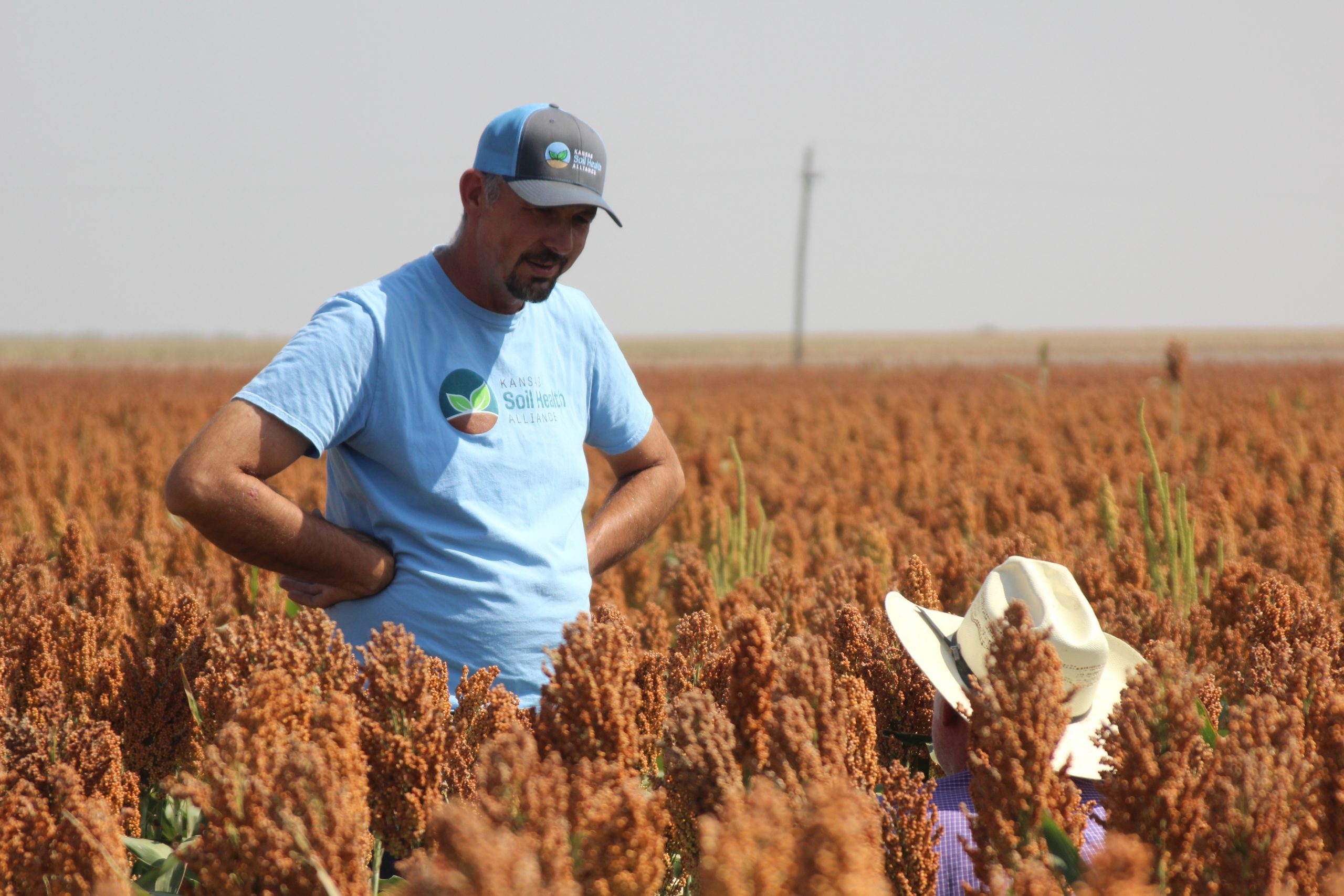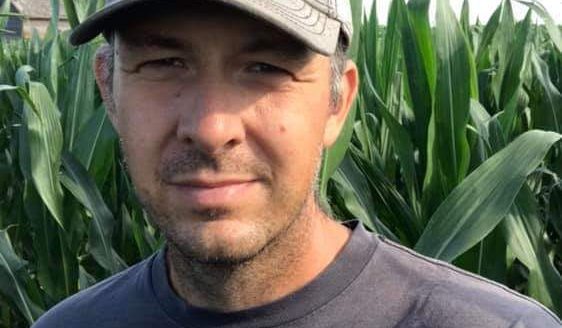Cover crops are on the minds of many producers but knowing how to approach the practice can be challenging.
During a recent Farmer 2 Farmer tour more than 70 people went to multiple fields in Pawnee County, Kansas, to evaluate different practices and perspectives—from grain and livestock producers.
Cover crops have gained increased attention in recent years as farmers look for ways to build soil health and, in some cases, they can receive added payments. Cover crops can be used for livestock grazing, they also can be used to provide cover for bare surfaces. They can control weeds and some cover crop species have deep roots to help break up soil compaction.
Jed Fleske, who was a tour host with an operation north of Larned, said in several of his dryland fields, noted cover crops helped this year as rainfall was spotty and below what Mother Nature generally provides. About 23 inches of moisture is expected each year and as of September most of his fields were about 5 inches deficient.
In June 2022, he planted cover crops in one of his fields after wheat harvest then planted sorghum this spring. The 80-acre field crop looked healthy. He encouraged several people to take shovels to dig into the soil. The soil showed the impact of dry weather but also where moisture was intact.
Cover crops work for Fleske. One reason he wanted to be on the tour was to show what he had learned but also to hear what others had to say. Listening is an important trait.
“We make mistakes, too,” Fleske said.
His advice was to pick a field and start with a small area. Fleske started 10 years ago as he wanted to improve his traditional cash crops of wheat, corn and sorghum.
“It’s been good for the ground and improved the soil health,” Fleske said.
He has been able to reduce some fertilizer costs and he says in times like this any expense savings helps.
The past decade he has seen the proliferation of pigweeds and kochia. Cover crops shade the ground and retard the weeds while the cash crops get off to healthy start.
There is no cookie-cutter strategy, which is why he encourages growers to network. “For your own operation you’ll have to figure for yourself what works and what doesn’t.”
Fleske still applies traditional chemicals for weed and insect control on an as-needed basis.
In another field on the tour Fleske showed where a corn crop had been harvested in fall 2022. He planted a cover crop after harvest that was then terminated and he plans to no-till wheat this fall. At that field he took out a 4-foot steel rod and pushed it into the ground to demonstrate there was ample moisture in the soil. Others on the tour also took part in the exercise.
Fleske said crop rotation was an integral part of his strategies and has included a wheat-sorghum-fallow practice.
The Farmer 2 Farmer cover crop bus tour was hosted by the Pawnee County Conservation District and the Kansas Association of Conservation Districts.
Kevin Wiltse, Timken, Kansas, uses cover crops as part of his grazing strategy that includes 60 animal days per acre. Rotating cattle in a paddock system is necessary. He has narrow corridors for the 160-acre tract.
He uses appropriate fencing and posts for ease of movement. He has other tracts that are set up into three corridors.
Sign up for HPJ Insights
Our weekly newsletter delivers the latest news straight to your inbox including breaking news, our exclusive columns and much more.
“The narrower the better,” Wiltse said. “I’m not saying it is right or wrong, but it is what works for us.”
He stressed in his operation the need to regularly check the fence quality of the paddocks because steers can push hard on a fence. Also it is important to make sure water is available.
Manure from the cattle puts nutrients back into the soil and the rotational grazing strategy prevents overgrazing.
“Livestock is a part of the ecological cycle,” he said.
He has used triticale and other crops as part of his mix. He is willing to try to different mixes each year.
This year’s cover crop was planted on May 3 when drought showed no signs of relenting. Wiltse was unsure at the time if the pasture could support livestock. He usually plants a cover crop in June but decided to plant early and hope that timely rains would fall, which he was thankful it did.
Wiltse prefers to calve in April and May and that complements the grazing time. He likes to keep the ground covered throughout the fall and winter because it captures snow.
Michael Thompson, Almena, is a 2022 Leopold Conservation Award recipient and says when it comes to soil health and cover crops the process is important to getting the results he expects in the long term.
If a farmer and rancher has decided to start with cover crops, Thompson said the producer should set a realistic goal and ask many questions.
“Don’t jump in with thousands of acres,” he said. “Start with your toughest piece of land and work with it first. I truly believe what’s best for the soil is best for you and then take the next step.”
Concentrating on moisture infiltration and building good ground cover pays, he said.
He also noted that farmers and ranchers can draw upon seeds from the sorghum family that are good for building sugar and soil mass.
Keeping the sun off bare ground prevents baking and drying the soil out. With proper management, even in dry years such as the ones growers faced this year, cover crops can help preserve moisture. He said triticale and cereal rye are cover crops that can be planted successfully after corn or sorghum harvest in the fall.
“Try to get educated and don’t be afraid to ask questions,” Thompson said and then quipped, “I have 14 years of mistakes to share with you.”
He encouraged growers to attend soil health events and demonstrations and work with their local conservation districts and the Kansas Soil Health Alliance. A helpful website is kssoilhealth.org.
Dave Bergmeier can be reached at 620-227-1822 or [email protected].
Cover crops that pay
By Dave Bergmeier
Getting some added monies for being a good steward is a win-win proposition.
Troy Munsch, an agreement consultant with the Kansas Association of Conservation Districts who has been working with the Kansas Climate Smart Initiative, said farmers can be paid added money for using good stewardship practices.
A year ago, ADM announced it would pay $10 an acre with a goal of enrolling 100,000 acres. Munsch said the multiple entities involved with the process boosted the total to 107,000 acres. The success led the parties to set an ambitious goal of 200,000 acres.
John Dryden, a Larned area farmer who showed several of this fields with cover crops, has enrolled his 2,500-acre farm into ADM’s cover crop incentive program. The $10 an acre generated $25,000 in additional revenue.
“Ten dollars may not seem like a lot, but it pays for my blended seeds,” he said.
Dryden had been using cover crops before the ADM program was rolled out, but he admitted he was “taking the cheap route” and instead of pursuing quality seeds he tried the least expensive and the result was a less than ideal cover crop.
The decision is paying off, he said, and he expects the soil health to improve even more. He has enrolled the acres into the second year.
“Weed suppression is big around here and I’ve been able to reduce chemical applications and still kill them. And water infiltration is going to continue to improve.”
He has used no-till practices to improve soil health, but he noticed the organic matter had “flatlined,” which means he needed a new approach to improving nutrients and infiltration. And that’s where cover crops came into focus.
The Pawnee County Conservation District has been a partner throughout the process, he said. ADM and Farmers Business Network streamlined the process. Mapping is not cumbersome in verifying the information.
Dryden said cover crops can work in the drier regions and encouraged fellow producers to keep an open mind and looking a blends of various cover seeds to provide diversification.
Munsch said newest program with ADM and FBN does have stipulations:
• It must not be part of another private regeneration ag or carbon program;
• Completion of enrollment survey and agreement has to be met;
• Completion of data collection with FBN and a closing survey must be accomplished; and
• There may be an onsite verification of practices for a randomly selected group of farmers.
The enrollment deadline for planned practices is Nov. 17, the data collection deadline is Dec. 1, and the payment date is May 31, 2024.
While the Kansas Association of Conservation Districts works with ADM growers may pursue agreements with other companies, Munsch said.
Several cover crop programs through ADM can pay producers from $10 to $25 an acre. Another program may allow a wheat producer to get paid $2 to $5 an acre depending on his cropping practice and other stipulations. Additional information is available at county conservation district offices.
The Environmental Quality Incentives Program, offered through the Natural Resources Conservation Service as well as numerous state programs administered by the local conservation district, can also be used by producers to help establish a cover crop program, Munsch said.
Dave Bergmeier can be reached at 620-227-1822 or [email protected].




